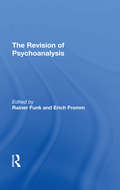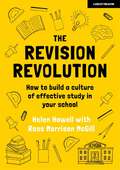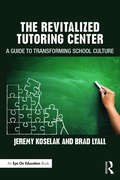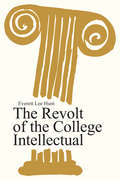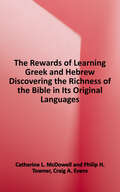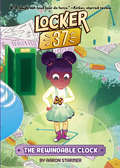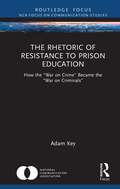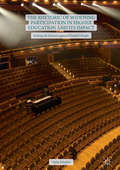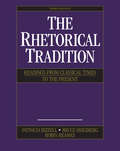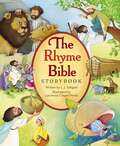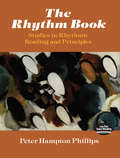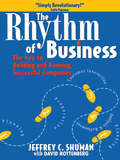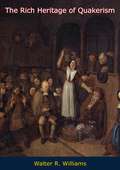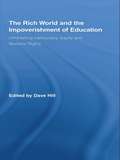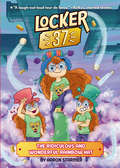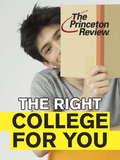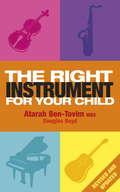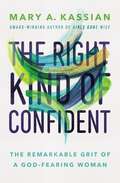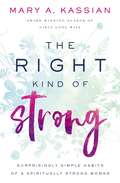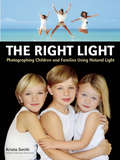- Table View
- List View
The Revision Of Psychoanalysis
by Erich Fromm Rainer FunkIn 1965 Erich Fromm became professor emeritus of psychoanalysis at the National Autonomous University of Mexico City. In the same year he finished his field research on the social character of the Mexican peasant village Chiconcuac. Released from his obligations at the university and free for a new project, he applied to various funding organizations for money to undertake a "Systematic Work on Humanistic Psychoanalysis," which he had decided to write in the course of the next few years. It was conceived as a work of three to four volumes that would deal with the complete range of psychoanalytic theory and practice. He intended nothing less than a dialectic revision.
The Revision Revolution: How to build a culture of effective study in your school
by Ross Morrison McGill Helen HowellHave you ever wondered why your students don’t revise? Or why they revise ineffectively? Often, they simply don’t know how. This is where The Revision Revolution comes in. What if, instead of just telling students to revise, we taught them explicit study skills from Year 7? What if we made revision enjoyable, even irresistible? The aim is not just to help students pass exams, but to embed their learning and help them grow into knowledgeable and informed young adults. In this book, Helen Howell and Ross Morrison McGill guide you step by step through how to start and sustain a revision revolution in your school, building a culture of effective study that flows through all aspects of school life.
The Revision Revolution: How to build a culture of effective study in your school
by Ross Morrison McGill Helen HowellHave you ever wondered why your students don’t revise? Or why they revise ineffectively? Often, they simply don’t know how. This is where The Revision Revolution comes in. What if, instead of just telling students to revise, we taught them explicit study skills from Year 7? What if we made revision enjoyable, even irresistible? The aim is not just to help students pass exams, but to embed their learning and help them grow into knowledgeable and informed young adults. In this book, Helen Howell and Ross Morrison McGill guide you step by step through how to start and sustain a revision revolution in your school, building a culture of effective study that flows through all aspects of school life.
The Revitalized Tutoring Center: A Guide to Transforming School Culture
by Jeremy Koselak Brad LyallTapping into the existing resources and staff available within your school, The Revitalized Tutoring Center provides an effective strategy to improve instruction and student performance. This practical guide shares the blueprint, best practices, and resources necessary to create and implement a robust, embedded tutoring center. This dynamic peer tutoring model brings together teachers, peers, and community members in a support network that identifies students in need and facilitates individualized instruction. With a peer tutoring model in place, schools are better positioned to initiate and sustain a variety of initiatives such as PLCs, RTI, formative assessment, community partnerships, and service learning, while creating equitable access and opportunity for all. This book illustrates how instructional leaders can leverage existing resources in a sustainable and cost-effective way to implement a model that ultimately leads to cultural changes, innovation, and significant academic improvement.
The Revolt of the College Intellectual
by Hugh DaunceyThe exuberant explosions of old college days have traditionally been forgiven as somewhat enviable expressions of the high spirits of exultant youth. Are young intellectuals, now the dominant group in many colleges, less adolescent and more mature, or do their immaturities merely manifest themselves in different ways? As intellectual individualists, students do not usually care for group explosions unless they are for social causes such as the rights of minorities. But their adolescence often manifests itself individually in a superior condescension or in depressive inferiority complexes.This book is a fascinating account of the changes that have taken place in the backgrounds, attitudes, and, temperaments of students at the so-called prestige colleges. Though Everett Lee Hunt draws heavily upon his observations and experiences during more than thirty years as a dean and professor of Swarthmore College, his book is much more than a case study of one outstanding college. Hunt presents many concrete examples of student moods, customs, actions, and expressions of values. With wisdom and warmth he discusses three successive eras in the college schooling of American adolescents: guarded education, conformity to accepted ways, and intellectual individualism.Teachers, deans, student counselors, personnel workers, and school psychologists and psychiatrists will find this classic book of continuing interest in guiding their dealings with adolescent students. The Revolt of the College Intellectual may also interest students themselves, their parents, alumni, and all who are in anyway concerned with education as a preparation for life in a rapidly changing and troubled world.
The Rewards of Learning Greek and Hebrew: Discovering the Richness of the Bible in Its Original Languages
by Philip H. Towner Catherine L. McDowellWhy study biblical languages? The Rewards of Learning Greek and Hebrew: Discovering the Richness of the Bible in Its Original Languages is written to convince you that it’s worth it! Professors Catherine L. McDowell and Philip H. Towner have spent years opening the eyes of students to the riches that await those who study Hebrew and Greek, and they invite you to listen in. This book is designed for people who have never studied the biblical languages―everything is in English or English script, and everything is clearly explained. The Rewards of Learning Greek and Hebrew contains a number of case studies―some from the Hebrew Bible and some from the New Testament―that demonstrate the kind of accuracy and insight that await those who study the biblical languages. Each case study is accompanied by a testimonial from a student whose understanding of the Bible has been enriched by studying Greek or Hebrew. With encouragement from Christian scholars and pastors sprinkled throughout, The Rewards of Learning Greek and Hebrew gives you a taste of what awaits the student of biblical languages and encourages you to take the plunge.
The Rewindable Clock #2 (Locker 37 #2)
by Aaron Starmer"A laugh-out-loud tour de force." --Kirkus, starred reviewHidden away at Hopewell Elementary School is a magical locker that always delivers a solution to your problems--just not quite in the way you might expect.The unthinkable happens. Keisha forgets to do her science homework! The morning it's due, she rushes to Locker 37 and the locker gives her a clock. Not just any clock, mind you. It's a time-travel device that sends Keisha back to whatever time of day she wants during that particular school day, which means she can scrape together enough time in between her classes to finish her homework. Still, there's no time to help Carson with his stained shirt or to answer Bryce's gummy bear questions (don't ask). Keisha only has time to make things right--but should she use it for herself or for her friends?
The Rhetoric of Resistance to Prison Education: How the "War on Crime" Became the "War on Criminals" (NCA Focus on Communication Studies)
by Adam KeyThis book explores the discourse and rhetoric that resists and opposes postsecondary prison education. Positioning prison college programs as the best method to truly reduce recidivism, the book shows how the public – and by extension politicians – remain largely opposed to public funding for these programs, and how prisoners face internal resistance from their fellow inmates when pursuing higher education. Utilizing methods including critical rhetorical history, media analysis, and autoethnography, the author explores and critiques the discourses which inhibit prison education. Cultural discourses, echoed through media portrayal of prisoners, produce criminals as both subhuman and always-already a threat to the public. This book highlights the history of rhetorical opposition to prison education; closely analyzes how convictism, prejudicial and discriminatory bias against prisoners, blocks education access and feeds the prison-industrial-complex an ever-recycled supply of free prison labor; and discusses the implications of prison education for understanding and contesting cultural discourses of criminality. This book will be an important reference for scholars, graduate students, and upper-level undergraduates in the fields of Rhetoric, Criminal justice, and Sociology, as well as Media and Communication studies more generally, Politics, and Education studies.
The Rhetoric of Widening Participation in Higher Education and its Impact: Ending The Barriers Against Disabled People
by Navin KikabhaiThis book offers a critical investigation of the exclusion of individuals described as having ‘learning difficulties’ from participation in higher education. Using a postmodernist framework, the author explores the insights and experiences of a theatre group attempting to develop an undergraduate degree programme in the performing arts. In doing so, he provides a theoretical map of insights into discourses of power and knowledge, and makes transparent competing and contradictory discursive practices. Suggesting that ‘learning difficulties’ is a constructed and re-constructed discourse serving normative interests, the author demonstrates that despite the rhetoric of widening participation, individuals are intentionally beset by barriers, silenced and excluded from degree level participation. The author calls for a radical re-think of the notion of ‘learning difficulties’, segregated provision, access to employment in theatre, and critically questions the notion of participation in higher education. This pioneering volume will appeal to students and scholars of inclusive education, (critical) disability studies, cultural studies and the sociology of education.
The Rhetorical Tradition: Readings from Classical Times to the Present
by Patricia Bizzell Bruce Herzberg Robin ReamesThe Rhetorical Tradition, the first comprehensive anthology of primary texts covering the history of rhetoric, examines rhetorical theory from classical antiquity through today. Extensive editorial support makes it an essential text for the beginning student as well as the professional scholar.
The Rhyme Bible Storybook
by ZondervanThe Rhyme Bible Storybook brings classic Bible stories from the Old and New Testaments to life, retold in rhyme so that children are enthusiastic to read along, excited to read aloud, and, most importantly, eager to remember their favorite Scripture verses.Storybook Bibles are wonderful ways for young children to begin their journey into knowing and loving God&’s Word. The Rhyme Bible Storybook:Is ideal for children ages 4-8Features eye-catching art throughoutIncludes classic Bible stories from the Old and New Testaments told in read-aloud rhymeIs a popular a gift from parents and grandparents for birthdays, Christmas, Easter, and First CommunionsThe Rhyme Storybook Bible provides a unique and appealing way for children to hear God&’s truths, with its rhyming text and vibrant illustrations.
The Rhythm Book: Studies in Rhythmic Reading and Principles
by Peter PhillipsThis excellent textbook is directed to students and their teachers who want to further their mastery of rhythmic reading and notation. Through study of its principles, and through practice of the simple drills and exercises that occur throughout the book, readers can build the broad and fluent rhythmic vocabulary necessary for a good, basic understanding of music's essentials.Chapter by chapter, Peter Hampton Phillips, composer and educator, familiarizes the reader with the various signs, symbols, and units of rhythmic notation. For each area, he includes studies for playing and singing, and illuminating examples from nine centuries of music literature.The book includes a section on basic conducting technique and an appendix on sight-singing with drills that can enable singers and instrumentalists to "read ahead"; that is, to scan across the page, grasping new patterns as they appear. Other highly useful appendixes to this essential text demonstrate the principles of musical notation; illustrate a broad range of conducting patterns; list tempo markings in English, Italian, German, and French; and present typical problems and solutions of rhythmic notation.
The Rhythm of Business
by David Rottenberg Jeffrey C. ShumanThe Rhythm of Business identifies and describes the natural development process which all successful business people use intuitively when starting and running a business. Once you understand The Rhythm of Business, you will never feel lost or out of sync, no matter what business you are in, because The Rhythm of Business incorporates a process with concrete steps to attain business success applicable for any business. A lot of business books deal in `tips.' This book deals with the most fundamental principles in business. Fundamental principles might not sound interesting to someone who is trained to think in terms of the practicalities of daily business life, but, in fact, The Rhythm of Business is the most practical, down-to-earth business book you will ever read!Jeffrey C. Shuman has crafted a unique career as an entrepreneur, consultant, business professor, and author. He is considered a leading expert in the emerging field of entrepreneurial studies. His courses in entrepreneurship at Bentley College tap state-of-the-art knowledge about business creation. His writings include dozens of articles and a book on entrepreneurs and the business creation process.
The Rich Heritage of Quakerism
by Walter WilliamsIn this book, which was first published in 1962, Walter R. Williams presents a picture of the courage, faith, devotion, and sacrifice that have been displayed throughout the history of Quakerism. Biographical sketches of Quaker leaders challenge the reader to Christian integrity and selfless service. The principles of Quakerism and their influence on society are evident in this carefully researched history of the movement.
The Rich World and the Impoverishment of Education: Diminishing Democracy, Equity and Workers' Rights (Routledge Studies in Education, Neoliberalism, and Marxism)
by Dave HillAdvancing a powerful critique of neoliberalized education in many of the rich countries of the world (USA, Canada, Finland, Greece, Israel, Japan, England and Wales, and others), the chapters in this book, written by an international array of acclaimed and emerging radical educators and policy analysts, critically examine and evaluate: What neoliberal changes have taken place (e.g., privatization, vouchers, charter schools, weakening of democratic control of schools, setting up markets in schools and retreating from the comprehensive school principle, commercialization of education, new public managerialism in education)? What are the impacts of these changes on access and equal opportunities, on democracy and critical thinking, and on the rights, pay and conditions of teachers and ancillary/support staff?
The Ridiculous and Wonderful Rainbow Hat #3 (Locker 37 #3)
by Aaron Starmer"A laugh-out-loud tour de force." --Kirkus, starred reviewHidden away at Hopewell Elementary School is a magical locker that always delivers a solution to your problems--just not quite in the way you might expect.Locker 37 at Hopewell Elementary has been helping fourth graders solve their problems for as long as anyone can remember. So when Riley Zimmerman needs help pulling off the most ridiculous and wonderful prank the school has ever seen, the magical Locker 37 provides her with an equally ridiculous and wonderful rainbow hat that can clone anything that wears it. But will a group of clones, an untrustworthy bully, and 10,000 Ping-Pong balls be enough to help Riley pull off the most legendary prank in Hopewell's history?
The Right College for You
by Princeton ReviewChoosing a college is a complicated process--and it's not simply about picking the "best" or highest-ranked school that you can get into. In this short ebook, the experts at the Princeton Review provide advice and activities to help you find the college that fits you best. In The Right College For You, we'll help you figure out how to find and apply to schools where you'll be happiest both academically and socially. We'll take a concise but enlightening look at: · 18 factors that do & don't matter · Common mistakes to avoid while choosing a college · How to boost your chances of getting into the schools you select · 25 "Would You Rather?" questions to help identify what you want in a school · 7 activities to help you define the right college for you We'll help you evaluate the importance of factors like location, school size, cost and financial aid, campus culture, social scene, and majors offered. We'll look at your likes and dislikes, what you cherish about high school and what you want to leave behind, and how you want to spend your college years. We won't try to make your college decisions for you, but The Right College For You will help you through the complicated process of figuring out where you want to go to school and how to get in.
The Right Instrument For Your Child
by Atarah Ben-Tovim Douglas BoydThis unique book offers a simple and practical method of selecting the right instrument for the individual child.Starting with the physical and emotional make-up of the child and using questionnaires and charts, the authors systematically explain the pros and cons of various instruments. For instance, a child who loves company might not enjoy playing the piano as it is predominantly a solo instrument. It appeals more to quiet introverts and yet many a child has been forced to learn only to give up as soon as they are allowed. As well as examining each individual instrument, the authors give advice on how some of the pitfalls can be avoided and provide information on buying and practising. Based on years of research by the authors, whose experience is unsurpassed, this is a comprehensive and inspirational book that will help unlock every child's potential.
The Right Kind of Confident: The Remarkable Grit of a God-Fearing Woman
by Mary A. KassianWhat if we stopped placing our confidence in the things of this world—and instead put our trust in the only one who is truly trustworthy?As you begin to apply each chapter&’s material, you&’ll discoverthe true meaning of confidence,the difference between negative fear and positive fear, andhow to turn the Enemy&’s tool of fear on its head with strong confidence.Be honest: Who among us isn&’t plagued with fears, insecurities, and self-doubt?Popular wisdom says the solution is to simply believe more strongly in ourselves. But award-winning author and speaker Mary A. Kassian explains that the way to combat fear is with more fear—fear of a different kind.In this follow-up to her popular book The Right Kind of Strong, Kassian again draws on her vast biblical knowledge to show us a better way to navigate life. She compares the Bible&’s definition of confidence with the world&’s well-worn self-help formulas and sets us on the right path.Whether you&’re seeking more confidence or already feeling full of it, when you lean into a source of confidence that is unchanging, firm, and trustworthy, you&’ll become more like the bold, courageous woman God created you to be.&“In the fear of the Lord one has strong confidence.&” (Proverbs 14:26)
The Right Kind of Strong: Surprisingly Simple Habits of a Spiritually Strong Woman
by Mary A. KassianAward-winning author Mary Kassian provides readers a biblical guide to becoming the strong, resilient, capable women God created them to be.Our culture teaches us that it's important for women to be strong. The Bible agrees. Unfortunately, culture's idea of what makes a woman strong doesn't always align with the Bible's. As a result, Christians often have a skewed view of what constitutes strength. In The Right Kind of Strong, Mary Kassian delves into Paul's exhortation in 2 Timothy about the women of the church in Ephesus and uncovers warnings and truths about seven habits that can sap women's strength. She reveals how, by guarding against these seven pitfalls, Christian women can walk in freedom and grow to be strong God's way.
The Right Light
by Krista SmithThe key to being a successful portrait photographer is choosing a style of photography you are passionate about. While many photographers work in multiple areas to fill the off season or offer a variety of options, most photographers focus on one style of photography. Oftentimes, the photographers' location will dictate their style. For author Krista Smith, the sunny beaches of Florida are her inspiration to shoot primarily natural light portraits, and she applies that to capturing authentic and joyful family portraits. Whether photographing entire families, kids, babies or all of the above, Smith brings an ease and comfort to the shoots that is immediately evident in her pictures. And shows you how to create the same look in your environment or clients' homes.While passion plays a key role in creating memorable portraits, employing the right techniques is essential for consistently getting those perfect shots. Smith begins by detailing what equipment you'll need to get started and gives some insight on how and what to use. She emphasizes taking the time to figure out and hone a personal style of shooting. The book lists a number of tips for finding a style that fits, including taking inspiration from other photographers you admire, and deciding what kind of feeling you want to present. Once you start to find your style it's important to build your portfolio. Organizing shoots with friends and family and offering free shoots to aspiring models is a great place to start.Outdoor shoots are the most ideal settings when using natural light as your primary light source. The author lays out the shoot requirements and gives tips for scouting the best locations. To create a photo that stands out, it's important to be versatile. While a sweeping vista covered in flowers or grand mansion may be preferred as backdrops, these are often not an option for many. A city street with multiple building textures or a small field can be used from a variety of angles to create the feel of something grander.From there the author moves onto the basics of lighting in an outdoor setting. By explaining the fundamentals of the direction and quality of light and the use of reflectors, it allows the reader to prepare for any outdoor scenario. An entire chapter of the book dedicated to shooting strategies over the course of twelve hours. There are different requirements for shooting at different times of the day. The reader will learn how to make the most of the "golden hour" and adjust for problematic midday lighting. Adapting your approach for morning, evening and sunset sessions is also covered.Sometimes weather does not cooperate for an outdoor shoot. Luckily, there are plenty of options for using natural and available light indoors. Shooting in a client's house provides a comfortable setting for the family and this ease can come across in the photos. Window light is a powerful tool to have an understanding of for these shoots. It is possible to get a variety of shots from one window. Being able to see beautiful light in all kinds of locations opens up countless shooting opportunities.While lighting is essential, thoughtful posing plays many important roles. In a well-done family portrait, the models look relaxed and natural. Some people look this way naturally, others need assistance. And posing isn't always a static thing; it can be more like orchestrating, grouping people together and getting them to move around in just the right way. It can also be used to help distract from physical problem areas, and bring added style to a photo. In addition, pointers are given on how to relax anxious children, organize families for group shots and encourage spontaneous moments.Finally, Smith discusses the business side of portrait photography. As she states in the closing chapter, there is more to the business than taking amazing photos. Without a stable financial and marketing plan it is difficult to stay competitive and possibly, stay in business. Realistic pricing packages are key. Pricing competitively is good, but it's important to consider...
The Right Light
by Krista SmithThe key to being a successful portrait photographer is choosing a style of photography you are passionate about. While many photographers work in multiple areas to fill the off season or offer a variety of options, most photographers focus on one style of photography. Oftentimes, the photographers' location will dictate their style. For author Krista Smith, the sunny beaches of Florida are her inspiration to shoot primarily natural light portraits, and she applies that to capturing authentic and joyful family portraits. Whether photographing entire families, kids, babies or all of the above, Smith brings an ease and comfort to the shoots that is immediately evident in her pictures. And shows you how to create the same look in your environment or clients' homes.While passion plays a key role in creating memorable portraits, employing the right techniques is essential for consistently getting those perfect shots. Smith begins by detailing what equipment you'll need to get started and gives some insight on how and what to use. She emphasizes taking the time to figure out and hone a personal style of shooting. The book lists a number of tips for finding a style that fits, including taking inspiration from other photographers you admire, and deciding what kind of feeling you want to present. Once you start to find your style it's important to build your portfolio. Organizing shoots with friends and family and offering free shoots to aspiring models is a great place to start.Outdoor shoots are the most ideal settings when using natural light as your primary light source. The author lays out the shoot requirements and gives tips for scouting the best locations. To create a photo that stands out, it's important to be versatile. While a sweeping vista covered in flowers or grand mansion may be preferred as backdrops, these are often not an option for many. A city street with multiple building textures or a small field can be used from a variety of angles to create the feel of something grander.From there the author moves onto the basics of lighting in an outdoor setting. By explaining the fundamentals of the direction and quality of light and the use of reflectors, it allows the reader to prepare for any outdoor scenario. An entire chapter of the book dedicated to shooting strategies over the course of twelve hours. There are different requirements for shooting at different times of the day. The reader will learn how to make the most of the "golden hour" and adjust for problematic midday lighting. Adapting your approach for morning, evening and sunset sessions is also covered.Sometimes weather does not cooperate for an outdoor shoot. Luckily, there are plenty of options for using natural and available light indoors. Shooting in a client's house provides a comfortable setting for the family and this ease can come across in the photos. Window light is a powerful tool to have an understanding of for these shoots. It is possible to get a variety of shots from one window. Being able to see beautiful light in all kinds of locations opens up countless shooting opportunities.While lighting is essential, thoughtful posing plays many important roles. In a well-done family portrait, the models look relaxed and natural. Some people look this way naturally, others need assistance. And posing isn't always a static thing; it can be more like orchestrating, grouping people together and getting them to move around in just the right way. It can also be used to help distract from physical problem areas, and bring added style to a photo. In addition, pointers are given on how to relax anxious children, organize families for group shots and encourage spontaneous moments.Finally, Smith discusses the business side of portrait photography. As she states in the closing chapter, there is more to the business than taking amazing photos. Without a stable financial and marketing plan it is difficult to stay competitive and possibly, stay in business. Realistic pricing packages are key. Pricing competitively is good, but it's important to consider...
The Right Skills for the Job?
by David Robalino Rita Almeida Jere BehrmanCreating jobs and increasing productivity are at the top of agenda for policymakers across the world. Knowledge accumulation and skills are recognized as central in this process. More-educated workers not only have better employment opportunities, earn more, and have more stable and rewarding jobs, but also they are more adaptable and mobile. Workers who acquire more skills also make other workers and capital more productive and, within the firm, they facilitate the adaptation, adoption, and ultimately invention of new technologies. This is crucial to enable economic diversification, productivity growth, and ultimately raise the standards of living of the population. This report brings new ideas on how to build and upgrade job relevant skills, focusing on three types of training programs relevant for individuals who are leaving the formal general schooling system or are already in the labor market: pre-employment technical and vocational education and training (TVET); on-the-job training (OJT); and training-related active labor market programs (ALMPs). Several previous studies have discussed some of the flaws in current systems and outlined options for reform. As a consequence, there has been a shift away from the investment in pre-vocational training courses to programs to improve access to and the quality of general secondary education. There have also been calls to encourage a stronger involvement of the private sector in the provision of training, together with increased emphasis in the quality and relevance of the content. One result has been a push to rethink the governance and financing arrangements of training institutions. But overall policies at these three levels of the training systems remain disconnected and there has not been an integrated framework linking them to the market and government failures that need to be addressed. This book makes two important contributions. First, it takes an in-depth look at the types of market and government failures that can result in underinvestment in training or the supply of skills that are not immediately relevant to the labor market. Second, building on the analysis of the limitations of both markets and governments and the results of case studies and recent impact evaluations, the report develops new ideas to improve the design and performance of current training
The Right Start to Phonics: A Guide to Supporting Excellence in Early Phonics
by Rose BlairIf children are to access all phonics teaching effectively, they first need to know how to tune into and manipulate the sounds specifically needed for reading. The Right Start to Phonics shows readers how they can support children in gaining the skills they need to listen with accuracy, to differentiate between, manipulate and understand the sounds we hear. This experience will give them the knowledge and understanding needed to hear letter sounds and blend them together to eventually read words.Drawing on the latest research, the book shows how Early Phonics can be embedded across your provision and fit into the daily routine of any setting or school. Part One explores the role of play, the adult and the learning environment in supporting early phonics and listening skills. This is followed by a wealth of easy-to-use activities to support the development and refinement of these hugely important skills in our youngest children. All the activities are simple to implement with easily sourced resources and cover a range of early phonic skills.Full of playful, active and fun ideas to help young children develop the auditory skills they need to access the phonic code, this is essential reading for all early years and primary educators and parents.
The Right Thing to Do, The Smart Thing to Do Enhancing Diversity in the Health Professions: Summary of the Symposium on Diversity in Health Professions in Honor of Herbert W.Nickens, M.D.
by Brian D. SmedleyThe Symposium on Diversity in the Health Professions in Honor of Herbert W. Nickens, M.D., was convened in March 2001 to provide a forum for health policymakers, health professions educators, education policymakers, researchers, and others to address three significant and contradictory challenges: the continued under-representation of African Americans, Hispanics, and Native Americans in health professions; the growth of these populations in the United States and subsequent pressure to address their health care needs; and the recent policy, legislative, and legal challenges to affirmative action that may limit access for underrepresented minority students to health professions training. The symposium summary along with a collection of papers presented are to help stimulate further discussion and action toward addressing these challenges. The Right Thing to Do, The Smart Thing to Do: Enhancing Diversity in Health Professions illustrates how the health care industry and health care professions are fighting to retain the public’s confidence so that the U.S. health care system can continue to be the world’s best.
